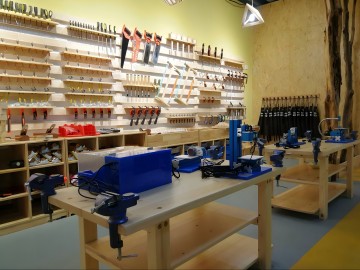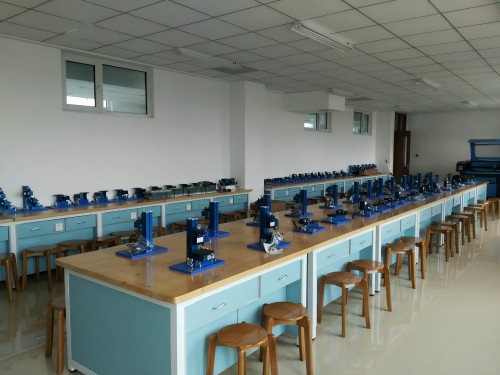Blog
Xendoll has 22 years of experience in the production of small machine tools. We will help you choose the suitable machine and share our experience in CNC machining with you.
 Oct 31, 2024
Oct 31, 2024
 Xendoll
Xendoll
 778
778
Small precision lathes are essential tools in the field of machining, widely used in education, model making, electronic product manufacturing, and more. As technology advances, an increasing number of users are focusing on how to efficiently and safely operate and maintain small precision lathes. This article will explore various professional issues related to small precision lathes, covering aspects such as machining accuracy, cutting tools, cutting parameters, maintenance, safety, software and programming, machining characteristics, and application areas.

In the machining process using small precision lathes, machining accuracy is a critical metric. High-accuracy machining ensures product quality and performance. To ensure the accuracy of the lathe, regular calibration of the equipment is essential. During calibration, high-precision measuring tools, such as micrometers and height gauges, should be used to ensure that the relative positions of various machine components meet design requirements.
Additionally, tool wear is another significant factor affecting machining accuracy. Regularly checking and replacing tools can effectively reduce machining errors caused by tool wear. Furthermore, setting cutting parameters such as cutting speed, feed rate, and depth of cut appropriately can also have a significant impact on machining accuracy.
The choice of cutting tools directly affects machining results and tool lifespan. Different materials require different types of cutting tools for processing. For example, carbide tools are typically suitable for machining metals, while high-speed steel tools are better for plastics and softer materials. Selecting the right tool material and geometry not only improves machining efficiency but also reduces tool wear.
For complex parts, users can opt for multifunctional tools that can perform multiple machining functions with a single tool, thereby enhancing efficiency. Additionally, a proper tool clamping method can improve machining stability and minimize vibration effects on accuracy.

Cutting speed and feed rate are two key cutting parameters that influence machining outcomes. Excessively high cutting speeds can lead to rapid tool wear, while low feed rates may impact production efficiency. In practical applications, cutting parameters should be optimized based on material characteristics and processing requirements.
For instance, for soft materials like aluminum alloys, increasing cutting speed can reduce cutting forces and heat generation, whereas for hard materials, lower cutting speeds are needed to prolong tool life by minimizing overheating. The use of coolant can effectively reduce heat generated during machining and improve stability.
Regular maintenance of small precision lathes is crucial for ensuring long-term stable operation. Daily maintenance should include regular cleaning, lubrication, and inspection of critical components. For lubrication systems, using specialized oils ensures coverage of all moving parts, reducing friction and wear.
Additionally, checking the motor and drive system regularly is an important part of maintenance. Ensuring that all connecting parts are tight and free from unusual noises can effectively prevent equipment failures. It is advisable to create a detailed maintenance schedule and document each maintenance activity and its timing for tracking the equipment's condition.

Safety is paramount when operating small precision lathes. Operators should wear appropriate personal protective equipment (PPE) such as safety goggles, gloves, and ear protection to prevent injuries during machining.
Moreover, keeping the work area clean and free of clutter helps reduce the risk of accidents. During operation, it is vital to be aware of tool sharpness and to ensure that hands remain clear of the cutting area while the machine is running. Developing specific operational procedures for high-risk tasks can ensure that all operators adhere to safety standards.
The use of computer-aided design (CAD) and computer-aided manufacturing (CAM) software is becoming increasingly common with modern small precision lathes. Utilizing CAD/CAM software allows users to create more complex designs and programming, enhancing machining precision and efficiency.
These software programs can assist users not only in part design but also in optimizing cutting paths to reduce machining time. In practice, users can simulate the machining process to identify potential issues in advance, thereby minimizing material waste and the rate of defective products.
The characteristics of the materials being machined significantly influence the outcomes. Different materials exhibit various thermal effects, deformation, and stress distributions during cutting, so controlling cutting parameters is critical.
For example, when machining hard materials, excessive cutting temperatures can cause material deformation, affecting the final part's accuracy. Therefore, it is essential to select appropriate cutting speeds and feed rates based on material properties and processing conditions, and to use coolant as needed to maintain temperature.
Small precision lathes are extensively utilized in various fields, including education, model making, electronic product manufacturing, and small batch production. In campus makerspaces, lathes serve not only as vital tools for students to learn machining skills but also as catalysts for creativity and hands-on experience.
In vocational schools' mechanical engineering programs, small precision lathes are indispensable for teaching foundational machining skills. Through hands-on experience, students can better understand machining principles and applications, laying a solid foundation for their future careers.
Small precision lathes play an increasingly significant role in modern machining. Through proper operation and maintenance, users can not only improve machining efficiency but also ensure accuracy and safety. Mastering related professional knowledge is vital for enhancing the use of small precision lathes. It is hoped that this article provides valuable insights for users, helping them achieve greater success in the machining field.



 Show all our samples
Show all our samples
 Provide you with a free quote
Provide you with a free quote
 Answer all the questions you may have
Answer all the questions you may have
 Guided installation and other options
Guided installation and other options